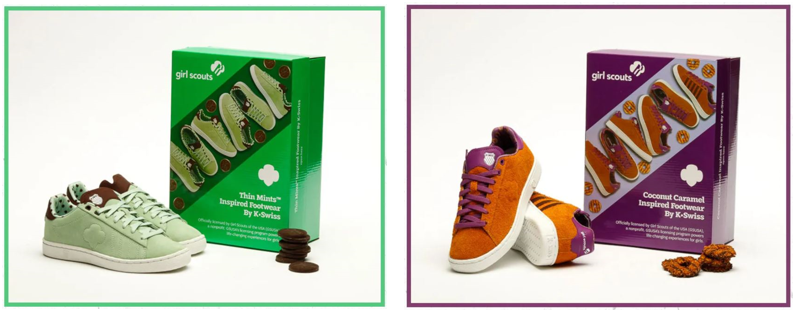In one of the more drool-worthy co-branding deals we have seen, K-Swiss recently announced a new line of Court 66 sneakers inspired by popular Girl Scout cookie flavors. The shoe boast colors and design elements inspired by Thin Mints, Samoas (sold as Caramel deLites in some markets), and Trefoils cookie brands. To our “deLite,” the co-branded sneakers are even sold in boxes that look just like the classic cookie packaging!
The Girl Scouts are no stranger to licensing their iconic brands – other cookie-themed collaborations in recent years include Yoplait yogurt, Nestle Crunch candy bars, Dunkin’ Donuts iced coffee, Bigelow tea bags, and Pillsbury baking mixes. Here are some things that brand owners should consider when entering into a co-branding deal with another company:
Carefully select a co-branding partner that will result in a mutually beneficial relationship for both brands
Successful partnerships can introduce the products of one company to the customers of the other. In the case of the K-Swiss collaboration, current and past Girl Scouts looking for fashionable footwear are introduced to K-Swiss sneakers, and K-Swiss fans may have a new reason to buy Girl Scout cookies this winter season – to match their shoes! Plus, the collaboration lends itself to some downright cute design elements K-Swiss would not otherwise be able to integrate into its footwear:
Source: https://kswiss.com/pages/girl-scouts-collection
Maintain strong quality control over all co-branded products
Quality control is always important to the integrity of a brand’s trademarks – in the case of co-branding, both companies need to ensure that the co-branded products are up to their quality standards to protect the reputation of their brands. A co-branding agreement should allow for both parties to inspect the co-branded products to ensure that both parties are abiding by the agreed-upon standards.
Outline a formal process for handling disputes between the parties and customer complaints about co-branded products
Co-branding can be all sunshine and rainbows in the beginning, but like any partnership, problems can arise. Strong licensing agreements include specific provisions for how both parties are expected to handle not only disputes with each other, but also complaints from customers.
Ensure that both brands are featured prominently on all co-branded packaging so that customers associate both brands with the products, and that branding for both companies conforms to specific branding standards
Customers should be able to easily identify the two sources of the products based on the packaging. In the case of the fun K-Swiss collaboration, the shoe box design that looks like a cookie box is easily identifiable by cookie fans, and includes K-Swiss branding too.
Having strong legal protections in place for both brands can result in a sweet deal for both companies – and can prevent any negative effects on the brand reputations of both parties so that nobody gets burned. And, as the K-Swiss/Girl Scouts collaboration illustrates, such undertakings can help boost the brand profile of both parties – while resulting in some unique offerings that can capture consumer hearts and…soles.
This article appeared in the March 2021 issue (Volume 41, Number 3) of “The Licensing Journal,” published by Wolters Kluwer, as “Brand Licensing: Tips to Ensure Your Co-Branding Arrangement Rises to the Top.” This article originally appeared in the February 2021 issue of MarkIt to Market®, published by Sterne, Kessler, Goldstein & Fox.
Related Industries
Related Services

Receive insights from the most respected practitioners of IP law, straight to your inbox.
Subscribe for Updates
